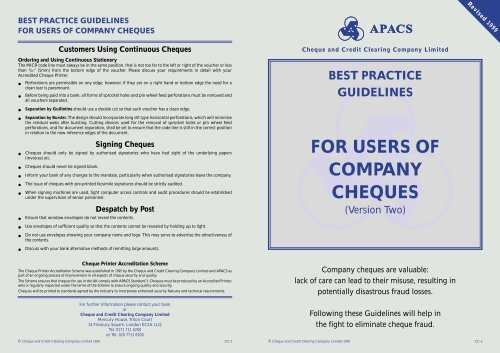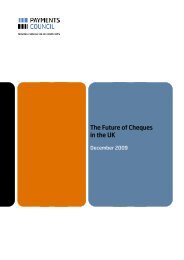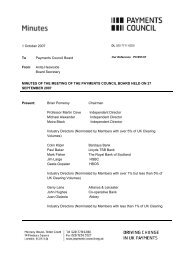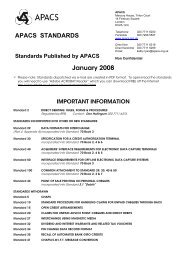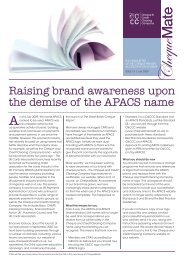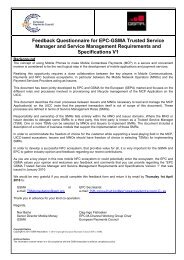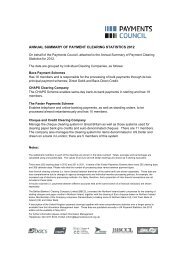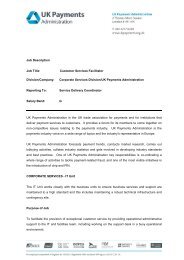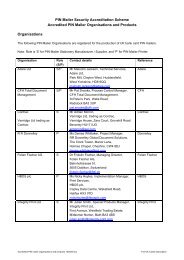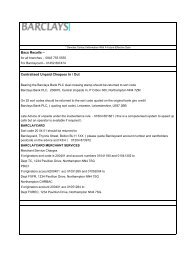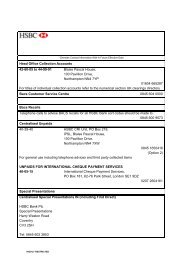FOR USERS OF COMPANY CHEQUES - Payments Council
FOR USERS OF COMPANY CHEQUES - Payments Council
FOR USERS OF COMPANY CHEQUES - Payments Council
You also want an ePaper? Increase the reach of your titles
YUMPU automatically turns print PDFs into web optimized ePapers that Google loves.
Revised 1999<br />
BEST PRACTICE GUIDELINES<br />
<strong>FOR</strong> <strong>USERS</strong> <strong>OF</strong> <strong>COMPANY</strong> <strong>CHEQUES</strong><br />
Customers Using Continuous Cheques<br />
Ordering and Using Continuous Stationery<br />
The MICR code line must always be in the same position, that is not too far to the left or right of the voucher or less<br />
than 3 /16 (5mm) from the bottom edge of the voucher. Please discuss your requirements in detail with your<br />
Accredited Cheque Printer.<br />
•<br />
Perforations are permissible on any edge; however, if they are on a right hand or bottom edge the need for a<br />
clean tear is paramount.<br />
•<br />
Before being paid into a bank, all forms of sprocket holes and pin wheel feed perforations must be removed and<br />
all vouchers separated.<br />
• Separation by Guillotine should use a double cut so that each voucher has a clean edge.<br />
•<br />
Separation by Burster. The design should incorporate long slit type horizontal perforations, which will minimise<br />
the residual webs after bursting. Cutting devices used for the removal of sprocket holes or pin wheel feed<br />
perforations, and for document separation, shall be set to ensure that the code line is still in the correct position<br />
in relation to the new reference edges of the document.<br />
Signing Cheques<br />
•<br />
Cheques should only be signed by authorised signatories who have had sight of the underlying papers<br />
(invoices) etc.<br />
•<br />
Cheques should never be signed blank.<br />
•<br />
Inform your bank of any changes to the mandate, particularly when authorised signatories leave the company.<br />
•<br />
The issue of cheques with pre-printed facsimile signatures should be strictly audited.<br />
•<br />
When signing machines are used, tight computer access controls and audit procedures should be established<br />
under the supervision of senior personnel.<br />
Despatch by Post<br />
•<br />
Ensure that window envelopes do not reveal the contents.<br />
•<br />
•<br />
Use envelopes of sufficient quality so that the contents cannot be revealed by holding up to light.<br />
Do not use envelopes showing your company name and logo. This may serve to advertise the attractiveness of<br />
the contents.<br />
•<br />
Discuss with your bank alternative methods of remitting large amounts.<br />
Cheque Printer Accreditation Scheme<br />
The Cheque Printer Accreditation Scheme was established in 1995 by the Cheque and Credit Clearing Company Limited and APACS as<br />
part of an ongoing process of improvement in all aspects of cheque security and quality.<br />
The Scheme ensures that cheques for use in the UK comply with APACS Standard 3. Cheques must be produced by an Accredited Printer,<br />
who is regularly inspected under the terms of the Scheme to ensure ongoing quality and security.<br />
Cheques will be printed to standards agreed by the industry to incorporate enhanced security features and technical requirements.<br />
APACS<br />
Cheque and Credit Clearing Company Limited<br />
BEST PRACTICE<br />
GUIDELINES<br />
<strong>FOR</strong> <strong>USERS</strong> <strong>OF</strong><br />
<strong>COMPANY</strong><br />
<strong>CHEQUES</strong><br />
(Version Two)<br />
Company cheques are valuable:<br />
lack of care can lead to their misuse, resulting in<br />
potentially disastrous fraud losses.<br />
For further information please contact your bank<br />
or<br />
Cheque and Credit Clearing Company Limited<br />
Mercury House, Triton Court<br />
14 Finsbury Square, London EC2A 1LQ<br />
Tel: 0171 711 6200<br />
or Tel: 020 7711 6200<br />
Following these Guidelines will help in<br />
the fight to eliminate cheque fraud.<br />
© Cheque and Credit Clearing Company Limited 1999 CC-2 © Cheque and Credit Clearing Company Limited 1999 CC-2
BEST PRACTICE GUIDELINES<br />
<strong>FOR</strong> <strong>USERS</strong> <strong>OF</strong> <strong>COMPANY</strong> <strong>CHEQUES</strong><br />
Ordering Company Cheques<br />
•<br />
Company cheques must only be purchased from a member of the Cheque Printer Accreditation Scheme, whose<br />
Accreditation Number and name must appear on each cheque. Orders may be placed through your bank, an<br />
Accredited Printer or a print broker/distributor. A full list of Accredited Printers is available from APACS or<br />
from your bank.<br />
•<br />
Official cheque orders should be signed by suitably authorised members of staff and placed with your bank,<br />
printer or print broker. Orders placed by telephone should always be followed up with a written confirmation.<br />
•<br />
When ordering continuous stationery please discuss with your printer how you will be infilling, separating and<br />
cutting cheques. This will ensure that the MICR (Magnetic Ink Character Recognition) code line is not<br />
compromised in any way. The printer can incorporate allowances in the cheque design, such as double guillotine<br />
cuts to remove perforations and marks to show the positions for guillotine cuts and slide slitting to remove<br />
sprocket holes.<br />
Cheques in Data Mailers<br />
•<br />
The production of cheques in data mailers is a specialised business. Please discuss your requirements in detail<br />
with your cheque printer. Ensure that the cheques and the method of infilling will comply with the requirements<br />
of APACS Standard 3 and that the data mailers will be produced by a specialist authorised by APACS to produce<br />
them.<br />
Control of Cheques<br />
• Ensure cheques are kept in a safe or a secure cabinet, particularly overnight.<br />
•<br />
Do not permit anyone to take blank cheques home with them, at any time.<br />
•<br />
Ensure that cheques have been removed from the computer printer after use and stored securely.<br />
•<br />
Ensure that cheque completion is properly supervised at all times.<br />
•<br />
Never leave cheques, whether signed or unsigned, on a desk unattended.<br />
• Avoid holding excess stock and shred any obsolete stock.<br />
•<br />
Take care to check against the possibility of individual cheques being removed from the middle of cheque books<br />
or from runs of computer cheque forms.<br />
•<br />
Ensure that spoiled cheques are properly accounted for and destroyed.<br />
•<br />
Undertake regular audits of cheque stock. Any discrepancies should be investigated and the bank advised.<br />
Infilling Cheques<br />
Cheques must be infilled in a way that deters fraudulent alteration. Always use black ink when infilling a cheque.<br />
Particular attention should be given to the following specifics:<br />
Payee Name<br />
•<br />
The Payee name should always be left justified. The payee name may be terminated by adding the word ‘only’<br />
after it or the space to the right of the name should be filled with asterisks or ruled through with one, or<br />
preferably a pair of horizontal parallel lines close together, ie: ======. Where two lines are allowed for a<br />
payee name, the second should be treated as a continuation of the first and asterisk filled or ruled through, even<br />
if the name does not overflow into the second line.<br />
•<br />
If a name and address appears on the cheque, eg for use in a window envelope, then the payee name must<br />
appear separately even if it is the same as the name in the address field.<br />
APACS<br />
BEST PRACTICE GUIDELINES<br />
<strong>FOR</strong> <strong>USERS</strong> <strong>OF</strong> <strong>COMPANY</strong> <strong>CHEQUES</strong><br />
Amount in Words<br />
•<br />
The amount in words should spell out in full at least the pounds part of the amount in figures, eg.<br />
£**43540-10** = ‘Forty three thousand five hundred and forty pounds 10p’.<br />
•<br />
The practice of having separate boxes to be filled with values ‘Zero’ to ‘Nine’ is not recommended. However, if<br />
they are used then all boxes must be completed to reduce the risk of fraudulent alteration.<br />
Amount in Figures<br />
•<br />
When completed on a computer or by typewriter, the amount in figures should be preceded and followed by<br />
two asterisks and left justified in the Amount Box, taking care that the leftmost asterisk does not touch or<br />
overwrite the ‘£’ symbol which is to the left of, and just outside the Amount Box. The amount should not<br />
include commas and the pounds/pence separator should be a hyphen.<br />
Letter Cheque or Remittance Advice with attached Cheque<br />
•<br />
Where more than one sheet is used to list the invoices to which the payment relates, all unused cheques<br />
must be CANCELLED or otherwise infilled in such a way that they could not be fraudulently misused.<br />
Computer Printers<br />
•<br />
Ensure access to computer programs is controlled by use of passwords and that all activities are recorded on an<br />
audit trail.<br />
•<br />
It is recommended that an impact printer with a permanent ink ribbon is used and that ribbons are changed<br />
regularly to maintain good print quality: faint print caused by a worn out ribbon makes a cheque much easier<br />
to alter.<br />
One time, or total transfer ribbons must not be used.<br />
•<br />
If a laser printer is used for infilling cheque details (payee name, date, amount, etc.) then ensure that it has been<br />
approved by Pira International Ltd, (the UK’s leading printing and paper research establishment) on behalf of<br />
APACS, as a Grade One laser printer. If it is required to print the personalisation details and the MICR code line<br />
then the laser printer will also need to be APACS approved for printing code lines.<br />
For more information on the use of computer printers (including laser printers), please refer to<br />
APACS Best Practice Guidelines for Companies using Computer Printers to Infill Cheques<br />
and APACS Best Practice Guidelines for Companies Wishing to Personalise Cheques,<br />
including adding the MICR code line<br />
Copies are available from your bank or APACS<br />
Typewriters<br />
•<br />
Total transfer (correctable) ribbons must not be used for completing cheques.<br />
• Ribbons should be changed regularly so as to maintain good print quality.<br />
Hand-written Cheque<br />
•<br />
Always use indelible pen (ball point) or permanent ink to complete cheques.<br />
•<br />
Never use felt tip pens, ‘erasable’ pens or pencils on cheques.<br />
•<br />
When hand-written, the amount in figures should be left justified in the Amount Box. A hyphen should separate<br />
the pounds and pence figures.<br />
APACS<br />
© Cheque and Credit Clearing Company Limited 1999 CC-2 © Cheque and Credit Clearing Company Limited 1999 CC-2


